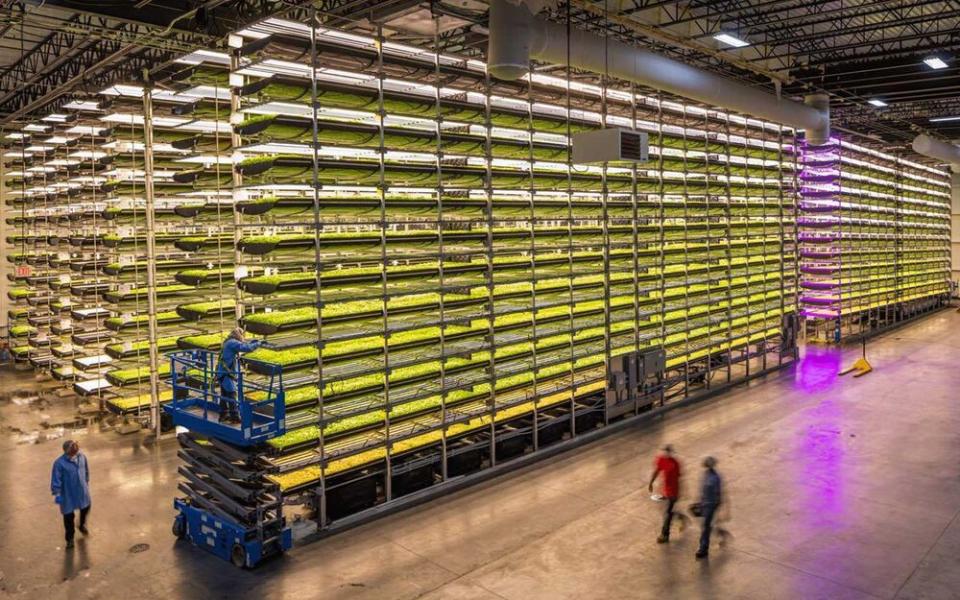The Secret to Singapore Airlines' Delicious Meals Is an Indoor, Vertical Farm in New Jersey
On an industrial block in Newark, New Jersey, behind the cement and brick Ironbound Recreation Center, there’s some magic happening. Inside a nondescript warehouse, sprouts are thriving under banks of LED lamps: kale, bok choy, arugula, tiny little plants only a horticulturalist could identify. Rows and rows and towers and towers of plants — like a scene from a super-sanitized version of "The Matrix" — are quickly becoming salad greens at AeroFarms. This 70,000-square-foot vertical farm, which the company says is the largest of its kind in the world, is hidden in plain sight — as planes roar overhead, on final approach for Newark Liberty International Airport.

During a recent visit to the farm, Travel + Leisure got an up-close look at how aeroponic farming works: A variety of greens are grown from seed to harvest, planted not in soil but rather in reusable cloth that’s woven from recycled plastic water bottles. Lettuces and other leafy greens are constantly monitored, and environmental sensors throughout the facility make frequent adjustments. AeroFarms co-founder and chief marketing officer Marc Oshima says they’re even able to alter the taste of their crops — say, making arugula that much more peppery — by manipulating water levels, lighting, and other factors. (They don’t, he’s quick to point out, use any pesticides or herbicides.)
Despite the energy-intensive technology powering the operation, AeroFarms says its food is significantly better for the environment compared to traditional farming. A single square foot of vertical farm — like the one in Newark — can yield 390 times the produce as one outdoors, Oshima says. Water use is limited, as the plants are grown aeroponically and only misted when necessary. All this helps reduce the carbon footprint of the food, both by greatly reducing the resources it takes to grow the greens in the first place and by putting the harvested crop closer to market.
That’s where Singapore Airlines comes in. The carrier, which operates the longest flight in the world between Newark and Singapore, has been working for years to reduce its carbon footprint, an airline rep says. One way to do that? Reduce the impact of on-board meals by sourcing greens from right down the road. AeroFarms, which is just a few miles from Singapore Airlines’s catering facility at Newark, is now supplying hyper-local produce for the nearly 19-hour Singapore Airlines Flight 21.
“Passengers understand that we’re trying to limit carbon footprint,” says Singapore Airlines food and beverage director Antony McNeil. Beyond that, high-tech vertical farming gives a level of control not found anywhere else, he says. “The beautiful thing is that we can work together to design, say, do we want more pepper in the arugula?” he says. “It’s like Star Trek!” Singapore Airlines will start serving AeroFarms produce on their flights from JFK International Airport, starting next month, and they may soon have sustainably sourced cuisine on all flights from the six U.S. cities the airline serves.
%image1
“The goal is, in the coming months, to have ‘farm-to-plane’ at every one of our U.S. gateways,” said James Bradbury-Boyd, a spokesman for Singapore Airlines. That could mean sustainably fished seafood for Seattle flights or thoughtfully made cheeses from Oregon aboard West Coast routes, McNeil said, in addition to vertically farmed greens.
For now, passengers will find AeroFarms produce in both business class and premium economy on flights from Newark, in these selections: Soy Poached Chicken, a riff on the classic Singaporean dish chicken rice; The Garden Green, a hot-smoked salmon salad; and Heirloom Tomato Ceviche, a sort-of caprese salad with burrata and arugula.
It’s possible that the partnership could grow in the future: AeroFarms has started an expansion of its Newark headquarters, which will give them even more space for indoor farming. And if they scale up, who knows? We may all soon be eating Star Trek–style salad in the air, no matter our destination.

